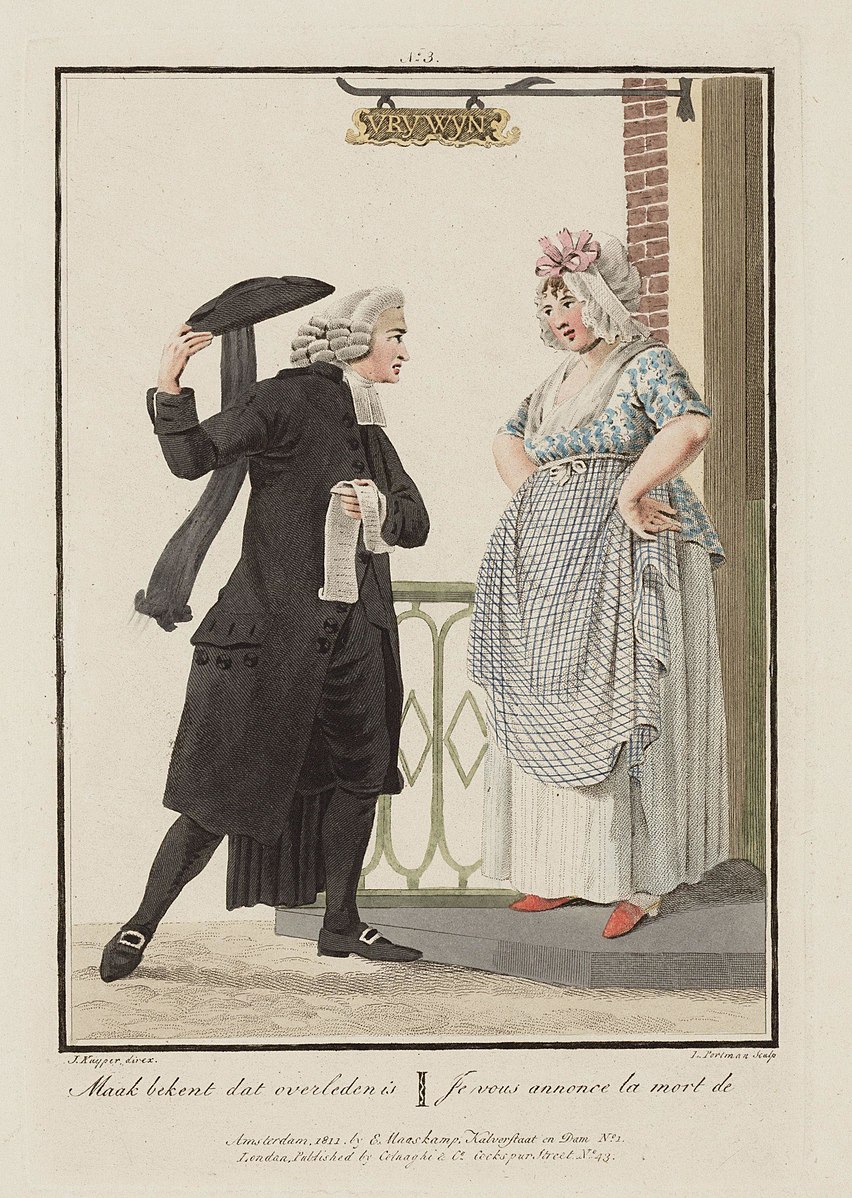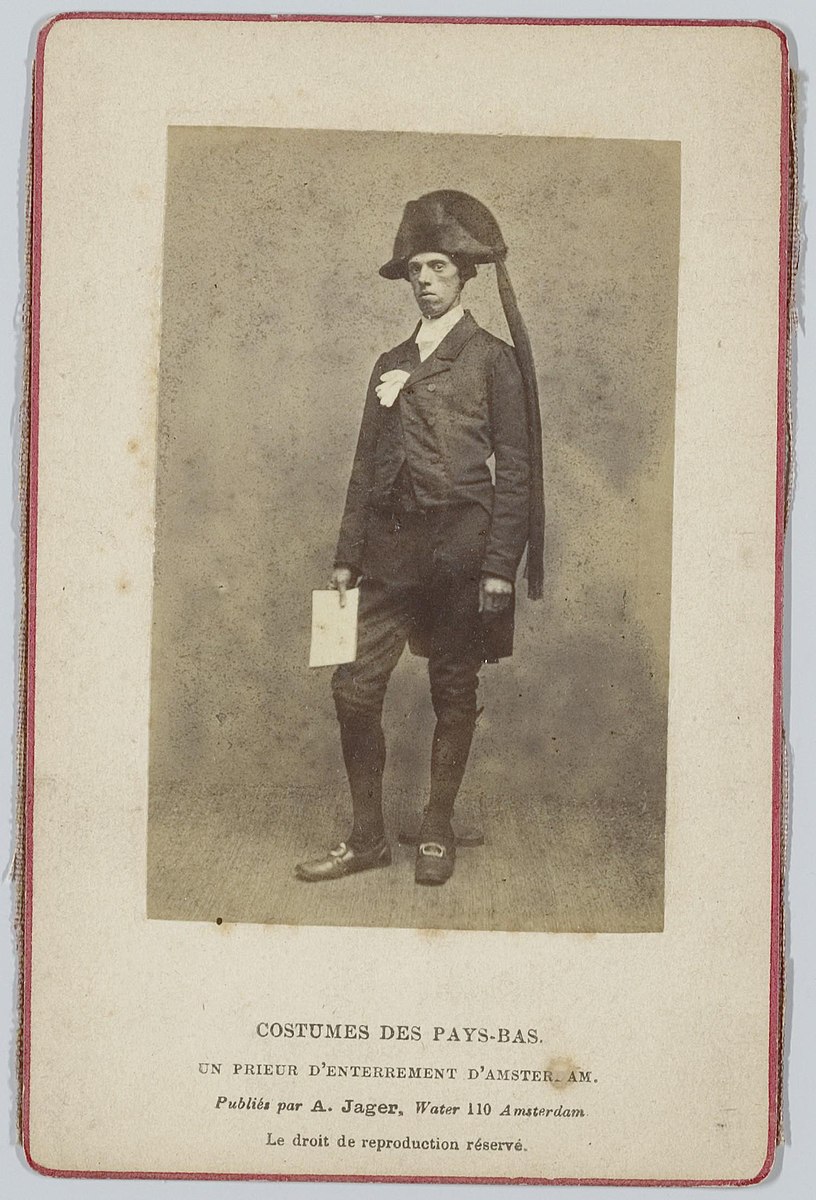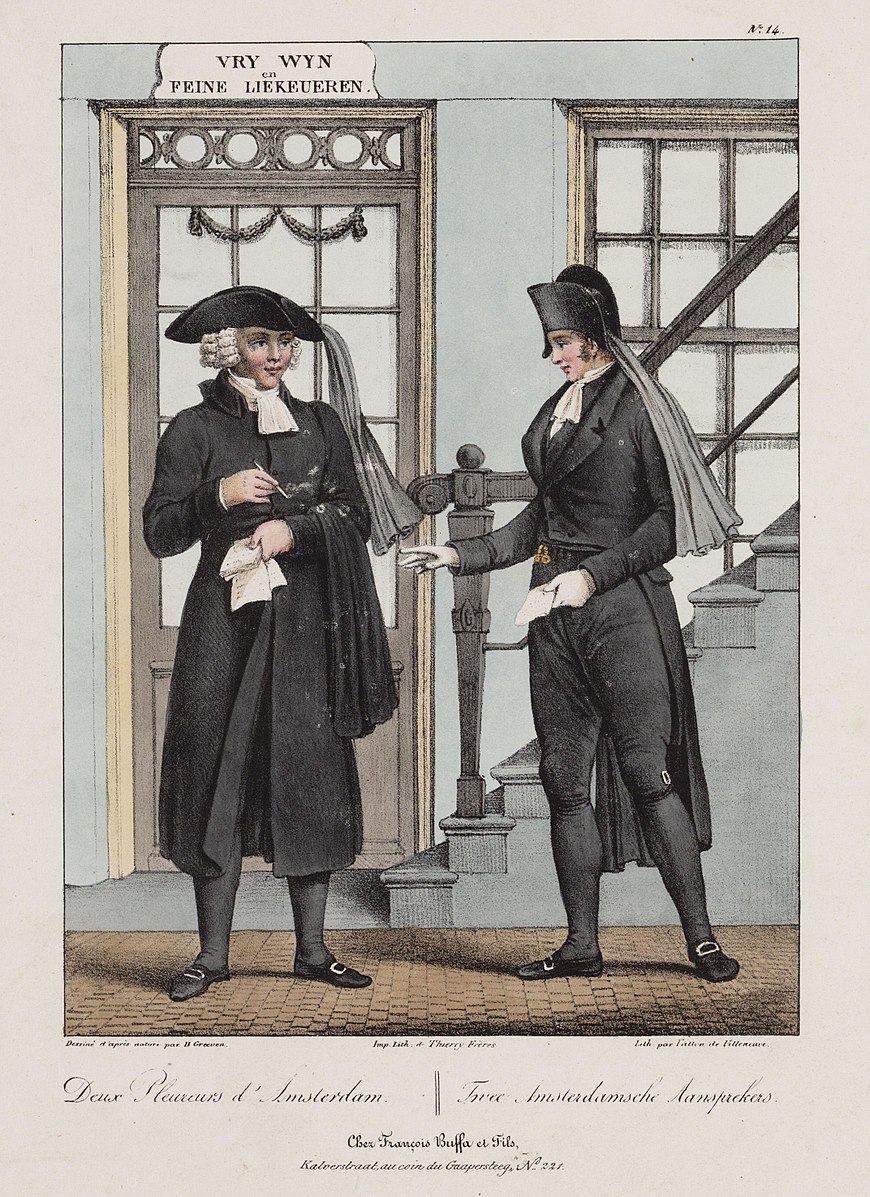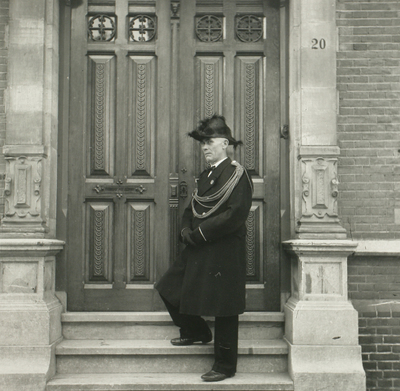Residents of colonial New York knew they were in for bad news when the aanspreker appeared at the door. Dressed all in black, from his dark knee-breeches and long cloak to a three-cornered hat adorned with black crepe streamers, he carried one message: someone was dead.

The aanspreker was a tradition brought to the 17th-century Dutch settlement of New Amsterdam from Holland. Aanspreker means speaker in Dutch, and what the appointed figure spoke was death. Before printed obituaries, or today’s digital options, the announcement of a person’s departure was often the job of a specific person. In ancient Rome, a town crier might share this somber news among other public business, while in England, a funeral bidder would often go to home-to-home, offering a sprig of rosemary as a form of invitation.
Before his arrival in New Amsterdam, the Dutch aanspreker was sometimes accompanied by the huilebalk, or weeper, a figure who dramatically cried at the completion of each delivered message (and supposedly flowed more tears when well-tipped). Yet while the aanspreker survived into 20th-century Holland, the huilebalk did not. Blair Jaekel wrote in the 1912 travel book Windmills and Wooden Shoes that the huilbalk had “wept himself out of existence, probably on account of a simple dearth of apprentices.”

In the colonial iteration, the aanspreker worked alone. In the 1896 Colonial Days in Old New York, historian Alice Morse Earle described what unfolded immediately following a death. After a slow tolling of the church bell, the aanspreker would set out into the streets, knocking on doors and informing relatives and friends of the time and place of the funeral. This “inviting was a matter of most rigid etiquette; no one in these Dutch-American communities of slightest dignity or regard for social proprieties would attend a funeral unbidden,” writes Earle.
Because it was unheard of show up to a Dutch New York funeral without invitation, the aanspreker was important. How did he impart this sober information? Anyone who has come across a social media post sharing a person’s death alongside the noise of memes and status updates knows how jarring it can be when not given the appropriate sensitivity. In his 1905 A Wanderer in Holland, English writer Edward Verrall Lucas relates how a woman from Hilversum formally received this jarring aanspreker missive: “Please ma’am, the baker’s compliments, and he’s dead.”
Lucas, being a famed humorist for such publications as Punch, may have been being a bit satirical. Nevertheless, the aanspreker’s job was a heavy one, and some were more skilled at it than others. So how did one become an aanspreker? Within the small population of New Amsterdam, the appointed funeral-inviter was often also the gravedigger, bellringer, schoolmaster, and chorister. (And by recorded accounts, always a man.) We can get an idea of the breadth of this person’s responsibilities from one aanspreker who fell short. In the 2004 New Netherland: A Dutch Colony in Seventeenth-Century America, historian Jaap Jacobs includes a 1661 admonition by the burgemeesters, or mayors, of Claes van Elslandt, who was told he should not only take better care of the graves in the churchyard, but also to: “look after the bier being fetched and brought back to the proper place; to invite according to old custom everybody to the funeral to announce the death, to walk steadily before the corpse, and to collect, demand, and receive pay only for his service, without demanding and requesting more money on this account.”

As of 1691 they were public officers licensed by the mayor, with a man named Conradus Vanderbeck, according to city records, being “appointed and confirmed in the place of inviter to the buyriall [sic] of deceased persons.” Fees could vary due to distance traveled, with the inviter of Flatbush (in today’s Brooklyn) receiving 12 guilders for invitations to the funeral of an adult, and an additional four if he went to New York (today’s Manhattan), not great pay for a long row across the East River. The especially wealthy dead might demand a whole troop of funeral inviters. Harriet Phillips Eaton writes in the 1899 Jersey City and Its Historic Sites that for the elite “there were often ten or even twenty Aansprekers employed to announced the death, and one, usually an old servant of the family, went in the middle of the street, walking slowly with bowed head and face buried in a large mourning handkerchief and led by two aansprekers.”
Later, in 1731, a law passed in New York mandated that these “inviters to funerals” receive 18 shillings for announcing the death of someone over 20 years old, 12 for those between 12 and 20, and 8 for children under 12 years old. (Perhaps the lower charges were an effort not to further burden a grieving family.)
Dutch New Yorkers took the rituals of dying and death very seriously. Before there was a doctor or clergyman in what would become Manhattan, there was a kranck-besoecker, or consoler, who attended to the dying. Friends and family were expected to watch over a person before and after their passing, a solemn task that was helped with ample drink and food. Rooms were draped in black; mirrors turned to face the walls. Special foods like doed-koecks, or dead cakes, were made, and either consumed or kept as mementos.

The aanspreker was just one part of these elaborate rituals, which encouraged every person in the community of the deceased to pause and mark their passing. It may all seem complicated and overly formal now, but in the 17th century these traditions, transported over the Atlantic Ocean to this new home, linked people together, and kept them connected to the place they’d left behind. After the English takeover of New Amsterdam in the late 1600s, these traditions began to fade, as the Dutch Reformed Church was overtaken by the Anglicans, and English eclipsed Dutch. The first Dutch cemetery, located on the west side of Broadway in today’s Lower Manhattan, is gone without a trace, with colossal office towers looming in its place.
In Holland, the aanspreker endured in the early 1900s, still stalking the streets with his dark attire and grim tidings, until he, too, eventually became obsolete. Print obituaries became standard, followed by their digital equivalent. Yet no matter who is tasked with this work, the announcement of death remains sensitive. Whether social media, a phone call, or an email, we’ve all become the modern aansprekers, attempting to soften some hard news in these messages, and create a moment of connection for that person’s memory.
